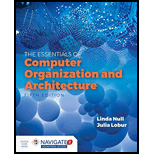
Explanation of Solution
a)
Converting 137 base 10 to base 3 using subtraction method:
Step 1:
Check the possibility of multiplying any integer with the powers of 3 which may result in lower number than 137. The number that can be subtracted from the given number 137 with the power of 3 is 81. The number 81 is less than 137. So subtract 81 from 137.
Step 2:
The number that can be subtracted from the given number 56 with the power of 3 is 27 and it should be multiplied by 2 in order to get the nearest number of 56. The number 54 is less than 56. So subtract 56 from 54.
Step 3:
Take 3 to the power of 2 that is 9. The number 9 is greater than 2. So make the value as 0.
Step 4:
Take 3 to power of 1 that is 3
Explanation of Solution
b)
Converting 248 base 10 to base 5 using subtraction method:
Step 1:
Check the possibility of multiplying any integer with the powers of 5 which may result in lower number than 248. The number that can be subtracted from the given number 248 with the power of 5 is 125. The number 125 is less than 248. So subtract 125 from 248.
Step 2:
The number that can be subtracted from the given number 123 with the power of 5 is 25 and it should be multiplied by 4 in order to get the nearest number of 123. The number 100 is less than 123. So subtract 100 from 123.
Step 3:
The number that can be subtracted from the given number 23 with the power of 5 is 5 and it should be multiplied by 4 in order to get the nearest number of 23
Explanation of Solution
c)
Converting 387 base 10 to base 7 using subtraction method:
Step 1:
Check the possibility of multiplying any integer with the powers of 7 which may result in lower number than 387. The number that can be subtracted from the given number 387 with the power of 7 is 343. The number 343 is less than 387. So subtract 343 from 387.
Step 2:
Take 7 to power of 2 that is 49. The number 49 is greater than 44. So make the value as 0.
Step 3:
The number that can be subtracted from the given number 44 with the power of 7 is 7 and it should be multiplied by 6 in order to get the nearest number of 44. The number 42 is less than 44. So subtract 42 from 44
Explanation of Solution
d)
Converting 633 base 10 to base 9 using subtraction method:
Step 1:
Check the possibility of multiplying any integer with the powers of 9 which may result in lower number than 633. The number that can be subtracted from the given number 633 with the power of 9 is 81 and it should be multiplied by 7 in order to get the nearest number of 633. The number 567 is less than 633. So subtract 567 from 633.
Step 2:
The number that can be subtracted from the given number 66 with the power of 9 is 9 and it should be multiplied by 7 in order to get the nearest number of 66. The number 63 is less than 66. So subtract 63 from 66
Want to see the full answer?
Check out a sample textbook solution
Chapter 2 Solutions
Essentials of Computer Organization and Architecture
- For this question you will perform two levels of quicksort on an array containing these numbers: 59 41 61 73 43 57 50 13 96 88 42 77 27 95 32 89 In the first blank, enter the array contents after the top level partition. In the second blank, enter the array contents after one more partition of the left-hand subarray resulting from the first partition. In the third blank, enter the array contents after one more partition of the right-hand subarray resulting from the first partition. Print the numbers with a single space between them. Use the algorithm we covered in class, in which the first element of the subarray is the partition value. Question 1 options: Blank # 1 Blank # 2 Blank # 3arrow_forward1. Transform the E-R diagram into a set of relations. Country_of Agent ID Agent H Holds Is_Reponsible_for Consignment Number $ Value May Contain Consignment Transports Container Destination Ф R Goes Off Container Number Size Vessel Voyage Registry Vessel ID Voyage_ID Tonnagearrow_forwardI want to solve 13.2 using matlab please helparrow_forward
- a) Show a possible trace of the OSPF algorithm for computing the routing table in Router 2 forthis network.b) Show the messages used by RIP to compute routing tables.arrow_forwardusing r language to answer question 4 Question 4: Obtain a 95% standard normal bootstrap confidence interval, a 95% basic bootstrap confidence interval, and a percentile confidence interval for the ρb12 in Question 3.arrow_forwardusing r language to answer question 4. Question 4: Obtain a 95% standard normal bootstrap confidence interval, a 95% basic bootstrap confidence interval, and a percentile confidence interval for the ρb12 in Question 3.arrow_forward
 Database System ConceptsComputer ScienceISBN:9780078022159Author:Abraham Silberschatz Professor, Henry F. Korth, S. SudarshanPublisher:McGraw-Hill Education
Database System ConceptsComputer ScienceISBN:9780078022159Author:Abraham Silberschatz Professor, Henry F. Korth, S. SudarshanPublisher:McGraw-Hill Education Starting Out with Python (4th Edition)Computer ScienceISBN:9780134444321Author:Tony GaddisPublisher:PEARSON
Starting Out with Python (4th Edition)Computer ScienceISBN:9780134444321Author:Tony GaddisPublisher:PEARSON Digital Fundamentals (11th Edition)Computer ScienceISBN:9780132737968Author:Thomas L. FloydPublisher:PEARSON
Digital Fundamentals (11th Edition)Computer ScienceISBN:9780132737968Author:Thomas L. FloydPublisher:PEARSON C How to Program (8th Edition)Computer ScienceISBN:9780133976892Author:Paul J. Deitel, Harvey DeitelPublisher:PEARSON
C How to Program (8th Edition)Computer ScienceISBN:9780133976892Author:Paul J. Deitel, Harvey DeitelPublisher:PEARSON Database Systems: Design, Implementation, & Manag...Computer ScienceISBN:9781337627900Author:Carlos Coronel, Steven MorrisPublisher:Cengage Learning
Database Systems: Design, Implementation, & Manag...Computer ScienceISBN:9781337627900Author:Carlos Coronel, Steven MorrisPublisher:Cengage Learning Programmable Logic ControllersComputer ScienceISBN:9780073373843Author:Frank D. PetruzellaPublisher:McGraw-Hill Education
Programmable Logic ControllersComputer ScienceISBN:9780073373843Author:Frank D. PetruzellaPublisher:McGraw-Hill Education





